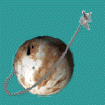
Current Issues:
SpaceViews
SpaceViews Update
Breaking News
Back Issues
Search
Subscriptions
Submissions
Forum
Space Sites of the Week
Home
Observing Information
We have compiled some resources to help you find the comet, including finder charts and ephemerides (lists of positions). We'll also include viewing tips as the comet passes through perihelion. A complete list of links to online viewing resources is also available
Where is the comet?
As the comet is one of the brightest objects in the sky, it won't be hard to find even in light-polluted city skies, but you still need to know where are when to look!
For those in much of the northern hemisphere, the comet is now visible in western sky after sunset, and will rise higher in the sky through mid-April before heading back down towards the horizon. We've provided two star maps to help you locate the comet: one shows how high above the horizon the comet rises, and the other shows the path the comet is following relative to the stars:
- Comet and the horizon (GIF, 10K)
- Comet and its path among background stars (GIF, 15K)
These charts are optimized for people living at mid-latitudes (approx. 42 degrees north, the latitute of Boston) but can still be used with only minor adjustments by people at other latitudes.
There are a number of other finder charts available online. The Daily Sky Chart for Hale-Bopp provides a sky chart updated each day showing the comet's location in the night sky. The Comet Hale-Bopp Interactive Finder Chart uses a Shockwave movie to allow you to trace the path of the comet across the sky. Sky and Telescope has also provided a number of finder charts on their Web site.
If you need a detailed list of positions of the comet, JPL has computed an ephemeris for the comet that lists the right ascension and declination of the comet for the next several months. The U.S. Naval Observatory provides an online form where you can enter you location and get a list of comet positions, including how high above the horizon the comet is at that time.
How do I observe the comet?
The comet is easily seen withe naked eye, and from a dark site you can make out a fairly long tail. If you have binoculars or a telescope, though, you can see even more detail in the comet.
A good starting place is the Viewing Hints & Tips page at JPL, which provides links to general resources about viewing the night sky and Hale-Bopp and links to astrophotography resources. This site is very busy, though, so you may want to visit a mirror site instead.
Sky and Telescope offers some information on how to estimate a comet's brightness and how to observe and photograph the comet. The New York Institute of Photography has some detailed tips on how to take photos of the comet.
I took some pictures of the comet. Now what?
Thanks to the Internet, and specifially the Web, you can share your observations, including any images you took, with fellow observers around the world almost instantly.
If you want to share your observing notes with others, you can use Dennis Ward's Comet Hale-Bopp Observation Notebook to read other's observations and submit your own. A simialr resource, the Amateur Astronomy Observers Log, is also online. You can also take advantage of Usenet newsgroups like sci.astro and sci.astro.amateur to exchange comet news and observations.
If you have comet images you want to share with the rest of the world almost instantly, you can use NASA's Near-Live Comet Watching System to upload your images and view new images from other observers. Be sure to send your images to JPL's Comet Hale-Bopp Home Page, which has the net's largest collection of Hale-Bopp images. This site is naturally very busy, so you may want to check out the mirror site.
